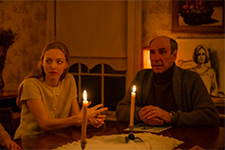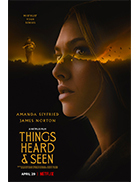Things Heard & Seen
|  Things Heard & Seen, which is based the 2016 novel All Things Cease to Appear by Elizabeth Brundage, is a tale of Gothic Horror 101, in which supernatural manifestations are but a reflection of the real horrors of interpersonal violence and familial breakdown. The Gothic novel, which developed in England in the late 18th century, was the product of a period of great social, cultural, and technological upheaval, which was embodied in the novels’ eerie tales of past and present colliding. Such stories were almost always centered around a female protagonist, featured a predatory male villain, and took place in some decaying castle or manor that gave concrete expression to the unburied sins of the past. All of those characteristics are in play in Things Heard & Seen, which was adapted and directed by the husband-and-wife filmmaking team of Shari Springer Berman and Robert Pulcini, who first garnered attention in 2003 for American Splendor, an adaptation of Harvey Pekar’s graphic novel series starring Paul Giamatti that earned them an Oscar nomination for Best Adapted Screenplay. Since then, their career has produce a wide and varied range of feature films (many of which are comedies), documentaries, and episodes of various television series. Nothing Berman and Pulcini have done before has suggested an interest in horror, but they have clearly internalized the traits of the genre, especially in its Gothic manifestation, which gives Things Heard & Seen its best moments, where the boundaries between the real and the supernatural are blurred, goosing us with suggestion and intimation that strengthens the marital drama at its core. The film opens with an ambiguous discovery of unseen violence, after which we meet George and Catherine Clare (James Norton and Amana Seyfried), a young married couple with a small daughter named Franny. They are about to move from the heart of Manhattan to a small town in upstate New York so that George, who has just finished his Ph.D., can take a job at a liberal arts college. This means that Catherine must leave her successful career as an art restorationist, something she is clearly not eager to do despite her commitment to supporting George in his career. George finds them an old, but oddly charming farmhouse that Catherine can pour her talent and energies into decorating, and he sets up at the college under the watchful eye of his department chair, Floyd DeBeers (F. Murray Abraham), with whom he shares an intellectual fascination with the 18th-century Swedish theologian Emanuel Swendenborg (the film’s title is derived from the full title of his 1758 treatise on the afterlife Heaven and Its Wonders and Hell From Things Heard and Seen). The difference, though, is that DeBeers is a true believer who thinks that Swendenborg’s writings about good and evil, spirituality, and the afterlife are a genuine insight into other dimensions of existence, while George keeps a studied intellectual distance. Like a many a horror movie character, he is reluctant to let go of rationality and embrace the dark unknown. Yet, the dark unknown refuses to be ignored, and soon Catherine is uncovering their house’s dark past of spousal violence and sensing the presence of others (as does Franny), while her marriage to George begins to unravel. George, whose glaring patriarchal ego becomes more and more lurid as the film progresses, sets his sights on Willis (Natalia Dyer), a depressive college student who is friends with Eddie Vayle (Alex Neustaedter), a handsome twentysomething local whose family used to live in the Clares’ house and who offers, along with his younger brother, to help out, thus creating the possibility of further sexual tensions once Catherine realizes what George is up to. Catherine’s frustrations, borne of both her physical isolation in the house and her emotional isolation from George’s emotional abuse, is palpable and reminiscent of many struggling women in modern Gothic horror, from Mia Farrow’s Rosemary in Rosemary’s Baby (1968), to Shelly Duvall’s Wendy Torrance in The Shining (1980). Like those films and their Gothic forebears, the horrors in Things Heard & Seen are primarily masculine, with the worst male traits—egotism, dominance, greed, ambition—morphing from vile, to murderous and, even worse, are cyclical. Gothic horror is ultimately about the unbroken cycle of patriarchal violence, and while Things Heard & Seen may seem like just another riff on “toxic masculinity,” its roots go much deeper. James Norton is particularly good as George primarily because he is so physically unassuming and at first seems like a pretty decent guy. Yet, it becomes more and more obvious that his obsession with his own self-interests and rise up the academic ladder are not just selfish, but lethal and the true embodiment of Swendenborg’s argument that love of self paves the way to hell. Amanda Seyfried give a fine, nuanced performance as Catherine, a woman who struggles to balance her commitment to her family with her own sense of self-preservation. The setting in 1979 makes no real sense except as a historical marker of late second-wave feminism heading straight into Reagan-era conservative retrenchment. Catherine’s attempts to assert herself intellectually and emotionally are constantly shut down by George’s unwillingness to bend or even hear her out, which is what makes the film’s grisly climax so distressingly obvious. Berman and Pulcini assemble the film well, crafting it with a fine sense of atmosphere that helps to give edge to some of the larger narrative lurches. They are aided significantly by cinematographer Larry Smith, who began his career in lighting on a number of Stanley Kubrick’s films, including Barry Lyndon (1975), The Shining, and Eyes Wide Shut (1999) before working as a director of photography on films like Nicolas Winding Refn’s Bronson (2008) and Only God Forgives (2013). Smith gives the film a dark, shadowy palette that threatens to engulf us, but without making things overly murky. Even when it is a bit too predictable and plodding for its own good, Things Heard & Seen looks gorgeous and unnerving at the same time, self-consciously and effectively in the same manner as George Inness’s painting “Valley of the Shadow of Death,” which plays a central role both narratively and thematically. Copyright © 2021 James Kendrick Thoughts? E-mail James Kendrick All images copyright © Netflix |
Overall Rating: 

 (3)
(3)


